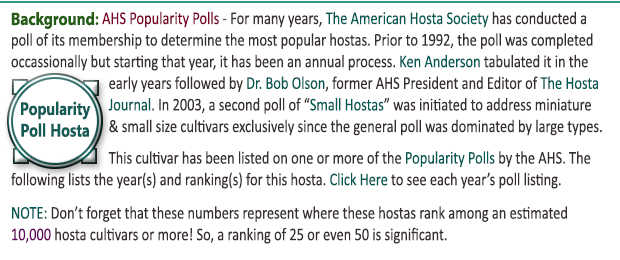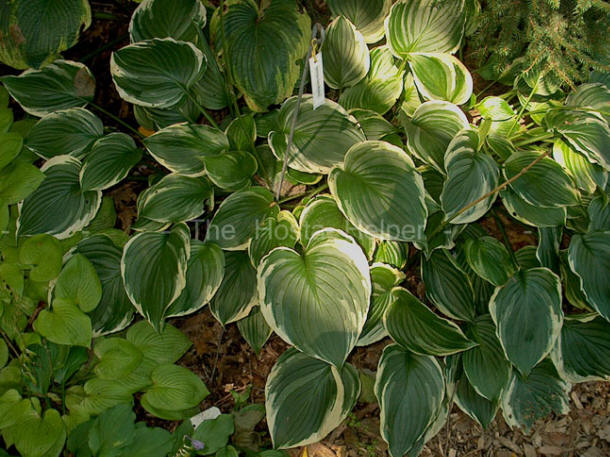  This
is another of the All-time Classics of hostas. It was registered by
The American Hosta Society in 1986 under the hyphenated name
H. ventricosa 'Aureo-marginata' on behalf of English
nurseryman, Alan Bloom
according to
The Hosta Handbook
by Mark Zilis (2000). Later it was determined
that this cultivar actually originated with Karel Hensen of the
Netherlands. This
is another of the All-time Classics of hostas. It was registered by
The American Hosta Society in 1986 under the hyphenated name
H. ventricosa 'Aureo-marginata' on behalf of English
nurseryman, Alan Bloom
according to
The Hosta Handbook
by Mark Zilis (2000). Later it was determined
that this cultivar actually originated with Karel Hensen of the
Netherlands.
It is a large size
plant about 22 inches high with a spread of around
47 inches. The medium to dark green foliage has a
yellow to creamy white marginal variegation. Its
leaves are broadly ovate with a heart shaped base,
shiny on the bottom and have a twisted tip. Bright
purple, bell-shaped flowers with stripes bloom in
July.
 The Genus Hosta by W. George Schmid (1991) changed the name to its current,
H. ventricosa
'Aureomarginated'. In 1993, Karel Hensen of the
Netherlands was
credited by
The American Hosta Society with actually introducing this plant. The Genus Hosta by W. George Schmid (1991) changed the name to its current,
H. ventricosa
'Aureomarginated'. In 1993, Karel Hensen of the
Netherlands was
credited by
The American Hosta Society with actually introducing this plant.
According to
The Hostapedia by Mark Zilis (2009), "Just the addition of a creamy margin to
H. ventricosa created one of the most outstanding hosta cultivars
in existence."
 Nomenclature changes recommended in the
1991 book The
Genus Hosta by
W. George Schmid and accepted by The American Hosta Society would update names as follows: H. ventricosa 'Aureomaculata'
and H. ventricosa 'Aureomarginata'. Nomenclature changes recommended in the
1991 book The
Genus Hosta by
W. George Schmid and accepted by The American Hosta Society would update names as follows: H. ventricosa 'Aureomaculata'
and H. ventricosa 'Aureomarginata'.

 An article about H. ventricosa 'Aureo-maculata' and 'Aureo-marginata' by W. George Schmid in
The
Hosta Journal (1985 Vol. 16) states that, "H. ventricosa is one of the oldest hostas in cultivation...The variegated form of H.
ventricosa that is now identified with the cultivar name of 'Aureo-marculata'
can be traced back to
P.F. von Siebold's time. In 1876, E. Regel published a
paper on hostas in Germany and in it referred to a "Funkia ovata forma
aureovariegata."...as a possible synonym for 'Aureo-maculata' form." An article about H. ventricosa 'Aureo-maculata' and 'Aureo-marginata' by W. George Schmid in
The
Hosta Journal (1985 Vol. 16) states that, "H. ventricosa is one of the oldest hostas in cultivation...The variegated form of H.
ventricosa that is now identified with the cultivar name of 'Aureo-marculata'
can be traced back to
P.F. von Siebold's time. In 1876, E. Regel published a
paper on hostas in Germany and in it referred to a "Funkia ovata forma
aureovariegata."...as a possible synonym for 'Aureo-maculata' form."
An article by C.H. Falstad about the stability of colors in hosta leaves in
The
Hosta Journal (2006 Vol. 37 No. 1) says, "However, in a
variegated plant, when the cells don't stay in place, the leaves can end up all
one color, as when 'Guacamole'...goes back to 'Fried Green Tomatoes'...In rare
instances, a complete pattern reversal can occur, as with 'Flame Stitch'...from
H. ventricosa 'Aureomarginata'...and 'Eskimo
Pie'...from 'Northern Exposure'..."


 |
 |
 |
 |
| 8 |
8.8 |
1975 #5
1985 #7
1990 #6 |
1991 #6
1992 #6
1993 #11 |
1994 #12
1996 #17 |
|
|
|
|





 |



